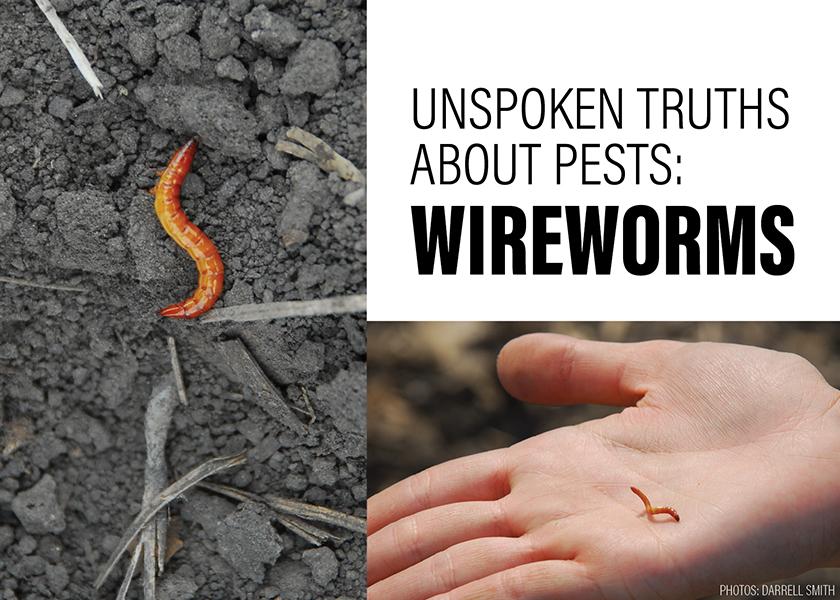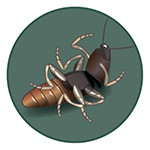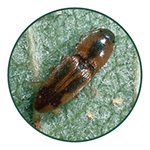Unspoken Truths About Pests: Wireworms

Look for signs of this early-season nuisance this spring
A Houdini of pests, the meager wireworm can be an unwanted guest for multiple crop seasons. Often called a secondary pest, this worm-then-beetle can stop crops in their tracks by snacking on seeds and seedlings.
The life cycle of wireworms can last four to seven years. Their various stages include:
- Eggs. Tiny white globules in soil.
- Larvae. Slender brownish worms that reach about 1½" long.
- Adult. Click beetles are long and skinny with rounded fronts and ends. Depending on the species, they range in size from 1/4" to 1½".
“Adult wireworms, which are known as click beetles, are not damaging to crops,” says Jeff Whitworth, Kansas State University entomology professor. “It’s in the larvae stage they do damage at ground level or below.”
MULTIYEAR DAMAGE
Wireworms feed on seed or seedlings of corn, soybeans, sorghum and other field crops. They can completely hollow out seeds or cut off the small roots of young plants. This results in gaps in rows or stunted plants.
Damage by first-year wireworms is typically minor, but that can change in subsequent years, which is when economic damage tends to occur.
“The fields where we have more trouble with wireworms are ones with lots of crop residue, no-till or reduced tillage,” Whitworth says. “The larvae can burrow 1' deep, following moisture and temperature gradients.”
In corn, insecticide seed treatments provide great control of wireworms. But that control only lasts 21 to 28 days after planting, Whitworth says.
“If wireworms are deeper in the soil at planting, they can come up and feed on seed and roots,” he says.
SAMPLE BEFORE PLANTING
If you’ve faced wireworm damage in previous years, sample fields before planting. Ken Ferrie, Farm Journal Field Agronomist, recommends using yield maps and aerial images from previous corn crops to identify problem areas and set bait stations.
Pay particular attention to sides of hills and small rises within fields, which tend to warm up first.
In those areas, Ferrie says to dig a few small holes in the soil and throw in handfuls of wheat and corn. Then, cover the holes with some black plastic to concentrate the heat units and speed up grain decomposition, which will attract the pest.
“Dig up that area and see if there are wireworms present,” Ferrie says. “If you find one wireworm per bait station, you’d better implement a plan to protect your crop.”
If a field has had wireworm problems, plant it last. Warmer soil leads to faster germination and growth, which reduce the amount of damage.
“Once a crop is established, wireworms can still feed on crops, but it won’t affect them,” Whitworth says. “It is all about timing of the crop.”
Soybeans, sorghum and other crops don’t tend to have the common wireworm insecticide seed treatment, he adds. If you have high wireworm samples, make sure you select seed with that protection.
For fields with wireworm damage, replanting might be necessary. Generally, Whitworth notes, the damage is contained to a small part of the field. If you do replant, wait for warmer soil temperatures, which lead to faster germination and crop growth.

Fast Facts About Wireworms
 The connection between a click beetle’s first and second section of the thorax is flexible, so they can move their heads and first pair of legs separately from the rest of the body. This lets them snap the two sections, making a loud click sound, and flip themselves over if they are lying on their backs.
The connection between a click beetle’s first and second section of the thorax is flexible, so they can move their heads and first pair of legs separately from the rest of the body. This lets them snap the two sections, making a loud click sound, and flip themselves over if they are lying on their backs.
The life cycle of certain wireworm species can last from four to seven years.
 Wireworm larva can live two to six years in the soil, feeding on roots of weeds, grasses and other crops. Adults can live for 12 months.
Wireworm larva can live two to six years in the soil, feeding on roots of weeds, grasses and other crops. Adults can live for 12 months.
Infrequent soil disturbance gives wireworms a chance to develop and survive.
Outdoor lights attract click beetles at night. If you see numerous small beetles on the ground  and some are flipping themselves into the air, you might want to use bait stations for wireworms a month or so prior to planting any nearby fields.
and some are flipping themselves into the air, you might want to use bait stations for wireworms a month or so prior to planting any nearby fields.
The several species of click beetles are distributed across the globe.
Read more from the Unspoken Truths About Pests series.







